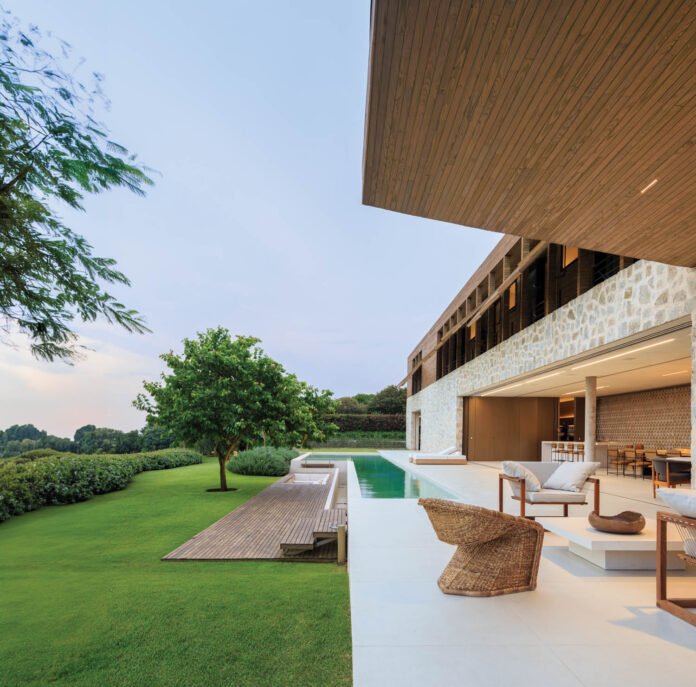The 3,000-acre upscale community of Fazenda Boa Vista is in Porto Feliz, about an hour from São Paulo, but a world away from the megacity’s relentless bustle. Envisioned by JHSF, developers of Brazil’s most exclusive shopping enclaves as well as its luxurious Fasano hotel group, the resort has become a favorite escape for well-heeled Paulistanos who prefer a weekend in bucolic horse country over the beach. A quarter of the site’s rolling green hillsides are preserved as pristine native forests and shimmering lakes. But the real attraction for weekenders-at-play are its abundant amenities and activities: two 18-hole golf courses, an equestrian center, a spa, tennis center, hiking and cycling trails, even a working farm and a kids’ club with an indoor skating rink.
This ambitious country idyll, its name translating roughly to beautiful view farm, has tapped some of Brazil’s best talents for its architecture. Isay Weinfeld conceived the Fasano hotel on the property, the equestrian center, and several neighborhoods of Fasano-branded residences. Other districts feature houses by Marcio Kogan and Uruguayan architect Carolina Proto. Add to the list of South American design luminaries Interior Design Hall of Fame member Arthur Casas, who designed a weekend villa for a São Paulo family overlooking the green expanses of one of Fazenda Boa Vista’s golf courses. Coincidentally, Studio Arthur Casas also did the home next door. Maintaining privacy–and aesthetic distinctions–between the two structures was key for the architect.
Inside a Weekend Retreat by Studio Arthur Casas


“I wanted this house to have its own identity,” Casas begins. The boxy, linear three-story home brings to life many of the signature elements of Casas’s work, especially dramatic spaces that smoothly integrate indoors and out by opening themselves completely to the surrounding landscape. In this house, a sprawling 14,000 square feet, the public rooms open onto a terrace extending the length of the swimming pool, then stepping down to a wooden deck, and finally a lush lawn bordering a golf course sand trap. The terrace, finished in large-format ceramic tiles, is a unifying element as well as a dividing line between the natural and architectural worlds.
Starkly different facade materials distinguish the base of the structure from the upper floor. The lower levels, which contain entertaining spaces, the main bedroom suite, a home office, gym, and a subgrade sauna with lounge, is finished in a rustic material typical of this region of the countryside. Hefts of granitelike Brazilian Moledo were cut on-site from larger pieces and set into a sandy mortar with wide gaps between the stones.
The upper level is clad entirely–from its pitched roof to the exterior walls–in horizontal slats of autoclaved pine that’s been injection-dyed to a carbonized finish. The same slatting finishes the flat roof of the ground-level living room and wraps onto the room’s angled interior ceiling. Window shutters on the five upstairs bedrooms pivot open to shade small balconies, creating privacy while letting in fresh air. When closed, the shutters blend with the exterior siding to render the upper floor a seamless wood-shrouded box, a favorite detail of Casas. “They merge with the facade so they’re practically imperceptible,” he explains. A metal arm locks each shutter, which is fitted with a counterweight for easy maneuvering, at fixed angles of 90, 45, and 30 degrees.
How the Home Design Reflects Architectural Traditions
Casas looked to a distinctly Brazilian invention—the cobogó, a ceramic or concrete-block brise-soleil inspired by traditional Arabic lattice screens—to filter sunlight and draw breezes in the expansive open kitchen and dining room he calls “the gourmet area.” The cobogó, a portmanteau of the surnames of its inventors (engineers Amadeu Oliveira Coimbra, Ernesto August Boeckmann, and Antônio de Góis), was first used in Brazil in the early 20th century and became popular through the work of mid-century architects like Lucio Costa and Oscar Niemeyer. The sculptural and sensory effects of its plays of light, shadow, and wind still appeal to architects in sunny tropical climates like Brazil’s. Casas formulated this hollow ceramic profile, a production piece for the Brazilian company Manufatti he previously used in the +55 Design store in São Paulo, as a pair of conjoined Y shapes, one upside down and the other right-side up. Thus was born the “Ipsilon Cobogó,” as in the Portuguese name for the letter Y. In this house, the screen wall takes on added meaning: The owners’ surname begins with a Y, making it an architectural monogram of sorts.


Throughout the house, Casas hewed to materials and finishes that “highlight the rusticity of a country house,” as the architect describes it. Suede, leather, cotton and linen fabrics, and natural-fiber and kilim rugs complement architectural surfaces in pine, porcelain, and ceramic. Furnishings are a mix of contemporary and vintage, mostly from Brazil. Casas’s own Jaky dining table joins his Três Toras table, which resembles a bundle of polished wood logs atop an andironlike curved metal base, in the living room, where there are also sculptural armchairs by Ricardo Fasanello, José Zanine Caldas, and Sergio Rodrigues. Collections of artisanal objects in the main bedroom and displays of rough-hewn ceramics reinforce the rustic-chic vibe. For Casas, such details—along with natural finishes and materials and a soft, neutral interior palette—are as much a part of the home’s sensitivity to the landscape as the building. As Casas puts it, “It’s an architecture that is respectful of its environment.”
Explore the Indoor-Outdoor Vacation Home

























PROJECT TEAM
studio arthur casas: nara telles; rafael palombo; fabíola andrade; marcos retzer; raimundo borges; diogo mondini; fernanda altemari; ana beatriz braga; luis lourenço; ana maria pedreschi; susana brolhani; claire dayan; julia sampaio; vinicius fadel; giovana micheloni; amanda tamburus; augusto godoi.
om studio: lighting consultant.
dedicatto: custom furniture workshop, woodwork.
epson: general contractor.
product sources
from front
lattoog: woven chair (terrace).
micasa: sofa (living room), desk (office).
etel design: chair, ottoman (main bedroom).
throughout
through dpot objeto; through espasso: furniture.
pedra moledo: stone walls.
manufatti: brise-soleil.
exbra: ceramic coatings.

